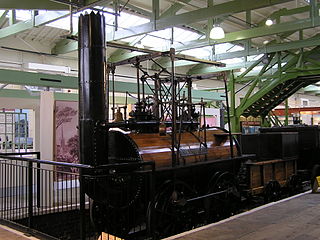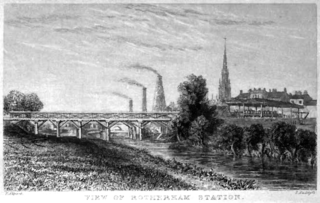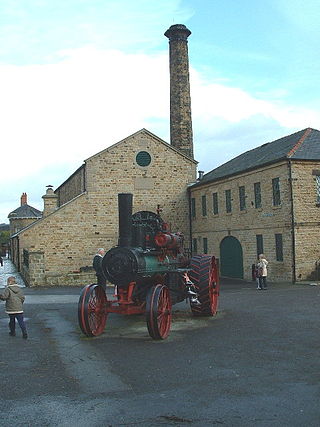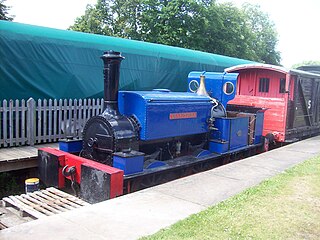
A geared steam locomotive is a type of steam locomotive which uses gearing, usually reduction gearing, in the drivetrain, as opposed to the common directly driven design.

Puffing Billy is the world's oldest surviving steam locomotive, constructed in 1813–1814 by colliery viewer William Hedley, enginewright Jonathan Forster and blacksmith Timothy Hackworth for Christopher Blackett, the owner of Wylam Colliery near Newcastle upon Tyne, in the United Kingdom. It was employed to haul coal chaldron wagons from the mine at Wylam to the docks at Lemington in Northumberland.

The North Tyneside Steam Railway and Stephenson Steam Railway are visitor attractions in North Tyneside, North East England. The museum and railway workshops share a building on Middle Engine Lane adjacent to the Silverlink Retail Park. The railway is a standard gauge line, running south for 2 miles (3.2 km) from the museum to Percy Main. The railway is operated by the North Tyneside Steam Railway Association (NTSRA). The museum is managed by Tyne and Wear Archives and Museums on behalf of North Tyneside Council.

Locomotion No. 1 is an early steam locomotive that was built in 1825 by the pioneering railway engineers George and Robert Stephenson at their manufacturing firm, Robert Stephenson and Company. It became the first steam locomotive to haul a passenger-carrying train on a public railway, the Stockton and Darlington Railway (S&DR).

The Sheffield and Rotherham Railway was a railway line in England, between the named places. The North Midland Railway was being promoted but its route was planned to go through Rotherham and by-pass Sheffield, so the S&RR was built as a connecting line. It opened in 1838. In Sheffield it opened a terminal station at Wicker, and in Rotherham at Westgate. When the NMR opened in 1840 a connecting curve was made between the two routes.

Elsecar Heritage Centre is a living history centre in Elsecar, Barnsley, England. It covers the industrial history of the area, and includes a Newcomen steam engine, the only such engine still in its original location.

The Yorkshire Engine Company (YEC) was a small independent locomotive manufacturer in Sheffield, England. The company was formed in 1865 and produced locomotives and carried out general engineering work until 1965. It mainly built shunting engines for the British market, but also built main line engines for overseas customers.

Manning Wardle was a steam locomotive manufacturer based in Hunslet, Leeds, West Yorkshire, England.

The Hetton colliery railway was an 8-mile (13 km) long private railway opened in 1822 by the Hetton Coal Company at Hetton Lyons, County Durham, England. The Hetton was the first railway to be designed from the start to be operated without animal power, as well as being the first entirely new line to be developed by the pioneering railway engineer George Stephenson.
Haigh Foundry was an ironworks and foundry in Haigh, Lancashire, which was notable for the manufacture of early steam locomotives.
R and W Hawthorn Ltd was a locomotive manufacturer in Newcastle upon Tyne, England, from 1817 until 1885.
The Avonside Engine Company was a locomotive manufacturer in Avon Street, St. Philip's, Bristol, England between 1864 and 1934. However the business originated with an earlier enterprise Henry Stothert and Company.
Earl Fitzwilliam's private railway near Rotherham, South Yorkshire, was constructed in order to link the Earl's coal interests to the southeast of his Wentworth estate with the Greasbrough Canal, also owned by his estate, which gave an outlet to the River Dun (Don) Navigation.
Waleswood Colliery was a coal mine situated between Swallownest and Wales Bar, near Rotherham, South Yorkshire, England. The colliery was adjacent to the Rotherham to Clowne road and the main line of the Manchester, Sheffield and Lincolnshire Railway about 2 miles east of Woodhouse.

George Stephenson built a number of experimental steam locomotives to work in the Killingworth Colliery between 1814 and 1826.

The South African Railways Class GM 4-8-2+2-8-4 of 1938 was an articulated steam locomotive.

The E.17 class was a class of patent long boiler steam locomotive built by the Robert Stephenson and Company for the New South Wales Government Railways of Australia.

The Hetton Colliery Lyon or Lyons is an early British steam locomotive that still survives in preservation. It is remarkable for having continued working into the early 20th century.

Steam springs or steam suspension are a form of suspension used for some early steam locomotives designed and built by George Stephenson. They were only briefly used and may have been used for fewer than ten locomotives.
Star was a locomotive designed by Isaac Dodds of the 2-2-0 configuration and built in 1833 at the Horsley Coal & Iron Company, Tipton, Birmingham, England. Despite rebuilds it was never a successful engine and was scrapped in 1840.














